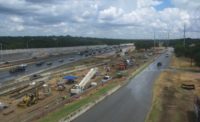Construction leaders across Arkansas, Louisiana, Mississippi, Oklahoma and Texas are optimistic about regional construction activity moving into the second half of 2018.
This confidence is strong despite new May figures from the Associated General Contractors of America (AGC), which show that, nationwide, the unemployment rate in construction increased from 6.3% in April 2017 to 6.5% last month.
Still, construction employment reached 7,174,000 in April, representing an increase of 17,000 for the month and 257,000, or 3.7%, over the last 12 months, notes AGC.
Construction employment is at the highest level since June 2008, the report further states.
Among the national leaders were the Houston-The Woodlands-Sugar Land, Texas area, which added the most construction jobs over the past year, a total of 5% or 10,700 jobs, while the Dallas-Plano-Irving area gained 6%, or 7,800 jobs. Midland, Texas, saw 23% growth with 6,000 new jobs.
Louisiana posted an estimated, not seasonally adjusted, 4.3% unemployment rate for February, the state’s second-lowest February rate on record, says the Associated Builders and Contractors Inc. (ABC). These estimates began in 2000—the lowest February rate for Louisiana was 4.1 % in 2006.
But this March, the state had the largest monthly increase nationally from February, 6.7%, up 2.4%, likely due to an influx of construction workers from other states seeking employment and previously discouraged unemployed construction workers reentering the job market, says Bernard Markstein, Ph.D., president and chief economist, Markstein Advisors, Washington, D.C., who provided the analysis of state construction unemployment rates for ABC. It was also the state’s second lowest March construction unemployment rate on record.
Still, the state also posted the country’s 10th-largest year-over-year unemployment decrease in March, 2.1%, tied with Illinois, he says.
Mississippi’s February rate was 6.8%, 16th lowest, and construction employment in March totaled 45,100, an increase of 3.4% from March 2017, Markstein adds.
Texas dropped to seventh lowest in February, 5.6%. In March, the state tied with South Carolina for 12th lowest, 6.2%.
For sure, Texas is vibrant. “We see no slow-down on the horizon. All sectors right now are very robust,” says Meloni McDaniel, president/CEO of TEXO, a joint chapter in Dallas/Fort Worth of AGC and ABC.
She explains that as families move into the area, infrastructure needs will grow, noting that the state is expected to have 50 million inhabitants by 2040.
San Antonio is equally robust, says Doug McMurry, executive vice president, the San Antonio Chapter of AGC. “Regarding the future, we see more emphasis on pre-fabrication and modular construction. Productivity will increase as bathrooms, MEP systems and exterior walls are built in a factory and transported to future construction sites.”
Texas continues to be one of the leading states nationally in terms of percentage job growth and net new construction jobs added over the past year. With Dallas, Austin is particularly strong, says Anirban Basu, chief economist, ABC, and CEO, Sage Policy Group Inc. in Baltimore.
In Arkansas, “we have enjoyed a steady increase in construction jobs over the past year as new development and construction projects continue to be very visible across the state, particularly in the central and northwest regions,” says Kevin Coakley, president of AGC Arkansas, Little Rock, and Coakley Company Inc., Hot Springs.
“We look forward to sustaining our momentum and contributions to economic growth in Arkansas with a solution for long-term highway funding and the impact of federal tax cuts,” he adds.
Oklahoma is also among the states adding jobs rapidly (11th nationally in percentage terms, January 2017–January 2018). But job growth in Arkansas and Louisiana, Basu notes, has been considerably softer.
Louisiana Slow
Meanwhile, Louisiana is having construction challenges—and not just because of the energy lull, says Ken Naquin, CEO, Louisiana AGC in Baton Rouge, representing 765 contractor and associate members. “Statewide construction is slow. I’ve been with AGC since 1979 and I have never seen it this slow: all forms of construction, all four corners of the state,” he notes.
AGC says that for March 2017 to March 2018, Baton Rouge lost 3,200 jobs, or -6%, which is the largest year-over-year loss nationwide for a metro area. Workers are simply leaving the state for work elsewhere, Naquin explains.
“Unfortunately, our legislature has yet to recognize that infrastructure, or the lack thereof, contributes directly to economic development,” he adds, noting that the state has lost at least $80 billion of industrial expansion to Texas because of the lack of transportation infrastructure. “Where we were once letting over $1 billion a year in infrastructure, today we’re at about $600 million annually.”
One segment, however, is strong. The Coastal Protection and Restoration Authority recently took proposals on the $1.2-billion Mid-Barataria Diversion project and will be doing the same on the Mid-Breton Diversion at $600 million, Naquin says.
Still, based on backlog, Louisiana should see considerable industrial investment in the next two years. “Bolstered by a petrochemical and transportation infrastructure network that is second to none in the U.S., southwest Louisiana is poised to experience tens of billions of dollars in investments between now and 2020,” Basu says.
Louisiana ranks first in construction environment nationally according to a new ABC scorecard, “Building America,” he adds. States are ranked on seven criteria: job growth, CTE education, workforce development, public-private partnerships, right-to-work, PLAs and prevailing wage.



Post a comment to this article
Report Abusive Comment